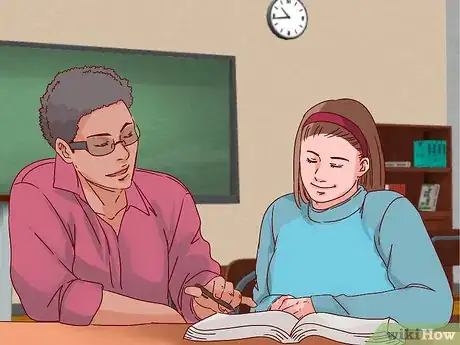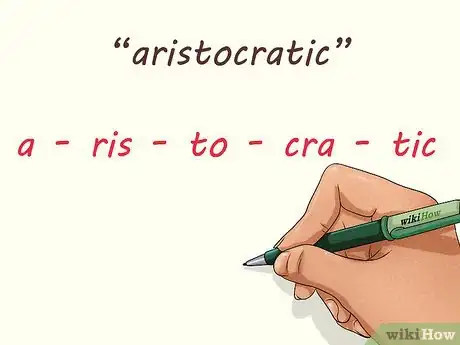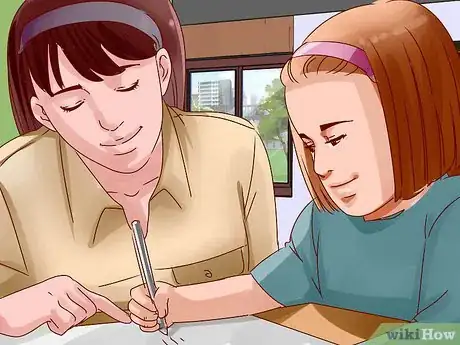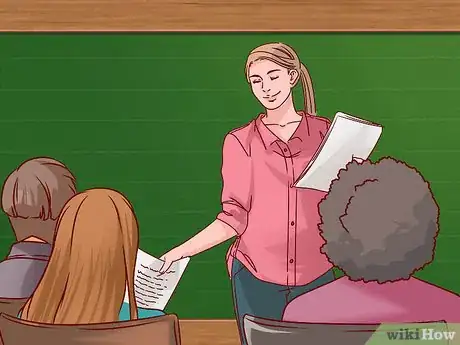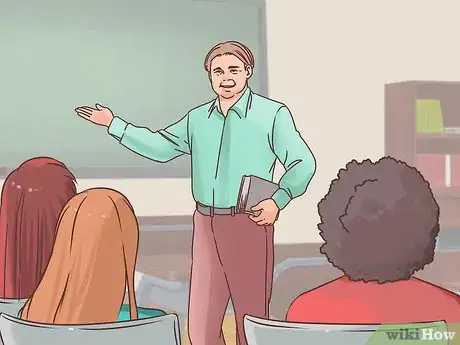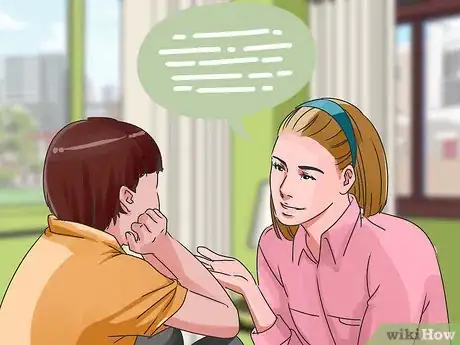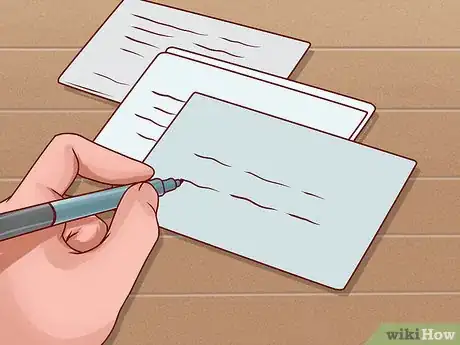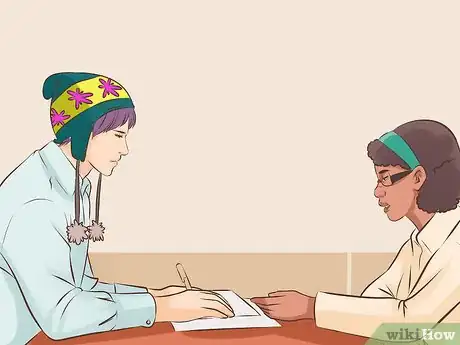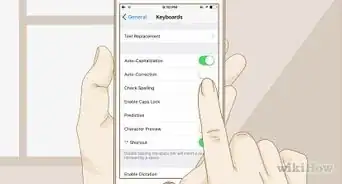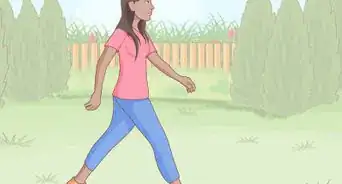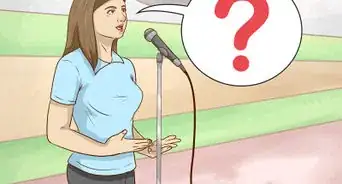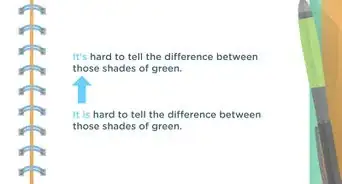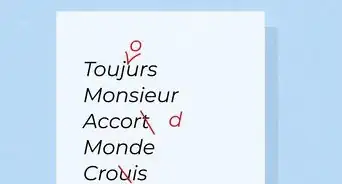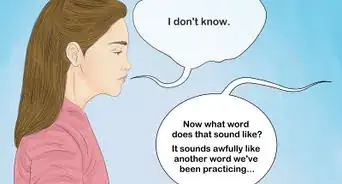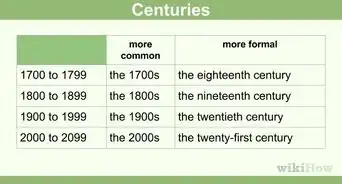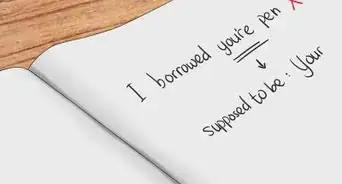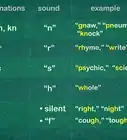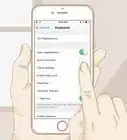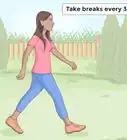This article was co-authored by Catherine Palomino, MS. Catherine Palomino is a former Childcare Center Director in New York. She received her MS in Elementary Education from CUNY Brooklyn College in 2010.
There are 14 references cited in this article, which can be found at the bottom of the page.
This article has been viewed 20,428 times.
Whether you are teaching a single student or are managing an entire class, teaching to spell is a big task. Fortunately, there are many different ways you can instruct students on how to spell. The most common way to teach beginners is to show them how to spell a word based on its sounds (known as phonics). You can also teach them how to recognize patterns in a word. This is known as word study. Games and tests can reinforce their lessons. Of course, some words will just need to be memorized, and you may need to adjust your lesson to the individual needs of each student.
Steps
Sounding Words Out
-
1State how each letter of the alphabet sounds. Write out the entire alphabet. Go through each letter, and state how it is pronounced. Ask the student to repeat after you. As you pronounce each letter, ask the student if they think it is a vowel or a consonant.[1]
- A consonant is a letter formed by moving your lips, tongue, or teeth. All letters except a, e, i, o, and u are consonants. When sounding out consonants, ask the child to tell you what part of their mouth is moving.
- Vowels are letters that can be pronounced without moving your lips, tongue, and teeth. The vowels are a, e, i, o, u, and sometimes y.
- For very young students, you may want to break up the alphabet into smaller sections, so that they can learn these concepts one at a time.
- Practice letter sounds regularly and quiz your child so they can master each sound.
-
2Create a list of simple words to work with. Choose words that are spelled exactly as they are pronounced. These are called decodable words. When you begin, use words that only have one syllable. Good words to start out with are words that end in “-at” (cat, hat, mat, sat) or “-an” words (can, tan, man, fan).
- You can find entire lists of decodable words online. These will help teach phonics without confusing the student with any complex spelling rules.
Advertisement -
3Say the word while emphasizing its sounds. First, you should say the word normally. For example, you might say the word, “cup.” Then you should stretch out the word to emphasize each sound (or phoneme) in the word. So you might say, “cuuuup. Cuh-uh-puh.”[2]
- Ask the student to repeat the word after you. Have them say it the same way that you did.
-
4Choose which letter creates the first sound. Have the student try to tell you before you help them out. If they're uncertain, walk them through the alphabet again. Point to each letter, and ask them if that makes the right sound. Write down each letter as they spell it.[3]
- If you are doing “cup,” start with the first sound. Say, “Cuh, cuh. What makes the cuh sound?” If they guess “K,” which makes a similar sound, gently correct them.
- Then move on to the next sounds. You might say, “Uh. What makes the uh sound?” or “Puh. What makes the puh sound?”
- When you are done, show the learner the word, and ask them to put all of the letters together again.
- Celebrate any success with your student. Tell them “Good job” or cheer for them when they're correct. Once they've mastered a difficult word, provide a small reward to keep them motivated.
-
5Break up longer words into segments. Once the learner can form basic, one syllable words, you might move onto longer words. Break up the word by syllable and have the student spell out each syllable. Then put all of them together, and spell the word together.[4]
- For example, you might sound out “spider.” Start by breaking it up into two syllables “Spi” and “Der.” Have the child sound out each syllable before putting them back together.
- Other good decodable words include “candy,” “volcano,” “unicorn,” and “pencil.”
-
6Demonstrate words with double vowels one at a time. Two vowels put together often create a different sound. Once the student has mastered basic phonemes, you can teach them how to spell with double vowels, but only focus on one at a time.[5]
- To teach “ai,” work through the words, “paint,” “mail,” and “rain.”
- To teach “ou,” you can use “house,” “mouse,” and “about.”
- A double “e” or “o” makes the vowel long. For example, you pronounce a long “e” in “peek” and a long “o” in “door.”
-
7Show them the rules with a silent “e”. There are a few different rules for using a silent “e” at the end of words. Teach these to a learner once they have mastered the other concepts of spelling. Some rules you may want to include are:
- An “e” at the end of a one syllable word makes the last vowel long. For example, if you add an “e” to “sat,” it becomes “sate.” Create a list of these words, and ask your student to sound out the difference between words with the “e” and words without the “e.”
- “E” is also added to the end of words that end in “v” or “u.” For example, there is an “e” at the end of “blue” and “sleeve.” It is also used at the end of non-plural words that end in "s," such as "house."[6]
Doing Word Study
-
1Create a list of words that all contain the same pattern. Choose one pattern for each study session. The idea is that you will teach the student how to identify different patterns of spelling, and they will learn to spell based on these patterns.[7]
- You might base this pattern on the endings of words. For example, create a list of words that ends only in “-ate” or “-ing.”
- You can base this pattern on the first letter of the words. This is good for consonants that might change sound based on their spelling, such as “c” or “g.”
- You can also use the vowels in the word. This is a good way to teach double vowels, such as “ai” or “oi.”
-
2Get the student to identify patterns in the way that the words are spelled. Do not tell the student what the pattern is. Ask them to find the similarities between all of the words on the list. Help them pronounce each word out loud so that they can hear how it sounds.[8]
-
3Point out the differences in the way that the words are spelled. Having each student say the words out loud can help. For example, they may notice that the c in “cat” is pronounced differently than the c in “chat.” Ask them why that might be and then explain why to them.[9]
- See if the student can identify the rules of spelling on their own. For example, they may notice that when “c” is followed by an “a,” it is pronounced with a hard sound while a “c” followed by an “e” is always soft.
- If they don't get it on their own, it is OK to explain it to them.
-
4Ask the student if they can spell out a different word. Choose a word that fits the pattern but wasn't on the original list. See if they can spell it now that they have learned the pattern. You may want to go through a few different words to test their skills.[10]
- For example, if you taught “igh” as your pattern, you might ask them to spell “night,” “eight,” or “right.”
Playing Spelling Games
-
1Find online games. There are hundreds of free, online spelling games aimed towards learners of all ages. Find one that is appropriate for your student's age and spelling ability. You might also use apps to teach the student. Some good websites include:
- Spelling City: https://www.spellingcity.com/spelling-games-vocabulary-games.html
- Learning Games for Kids: http://www.learninggamesforkids.com/spelling_games.html
- Vocabulary.co.il: http://www.vocabulary.co.il/spelling/
-
2Host an informal spelling bee. If you have multiple students, have them take turns spelling different words. If they spell one wrong, they are out of the game. Choose words and spelling patterns that you have been working on in class. Whoever spells the most words correctly wins.[11]
- These competitions are fun for older learners, including English language learners.
- If you are working one-on-one with a student, see how many words they can spell before they get one wrong. Next time you play the game, challenge them to beat their record.
-
3Make a word scramble. Take words that the student has been working on, and mix up the letters so that they are out of order. Ask the student to put the letters back into the right order. You can do several words at once.
-
4Do a word search. Hide words that you have been teaching within a random assortment of letters. Make a list of all of the hidden words, and ask the student to find and circle the words. This will require them to find patterns within random letters.
- There are many online websites where you can instantly generate word searches. Simply type in what words you want to use, and it will create a word search for you.
Addressing Students' Needs
-
1Give the student a spelling inventory test. An inventory test will determine how well they can already spell. You might show them pictures and ask them to spell the word. You can also do a multiple choice test, in which they must select the correctly spelled word from a list of misspellings.[12]
- Do not grade this test for points. This test is simply to see where the student is currently.
- You should make sure to test the learner every week or two to see how much they have learned and which concepts they are still struggling with.
-
2Make a unique spelling list based on the student's need. If the student is struggling with a particular concept, make sure to focus on those areas. Create new lists of words that tackle this unique problem. Continue to work on these concepts until the student has mastered what they were struggling with.
- Include words that you know your student can achieve so the list is achievable.
- For example, if your student can't figure out when to use “gh,” make a list of words that includes “through,” “night, “borough,” and “brought.” Have them memorize these words if they don't understand the rules.
- If you have multiple students, try to create a unique list for each of them.
- For large classes, break the students up into groups based on their level of spelling. Make a list for each group.
-
3Demonstrate how to study spelling. There are many irregular rules of spelling in the English language. While word study and phonics can help, students may need to memorize trickier words. Show the student multiple ways of studying these strange words.[13]
- Flashcards are a great tool. On one side, put a picture of the word, and on the other, spell it out. Show the student the picture, and ask them to spell the word.
- Review words you've already learned for a few minutes everyday.
- Reading simple picture books can help students recognize words and letters.
- Ask students to match the words with the picture. This will help them associate the letters of the word with the meaning.
-
4Provide extra assistance for students with learning difficulties. Some students may require more assistance than others. In addition, some people may have disadvantages when it comes to learning spelling. Be patient and sensitive with their situation.[14]
- If the student is diagnosed with dyslexia, you may need to spend more time on each word or pattern. If possible, see if you can get them extra attention from the school, either through a special education program or an after-school program.
- English language learners may use spelling habits from their native language. You may need to work with them one-on-one or in small groups to help them identify English spelling patterns.[15]
References
- ↑ http://www.ascd.org/publications/books/104134/chapters/Phonics-and-Word-Study.aspx
- ↑ http://www.auburn.edu/~murraba/spelling.html
- ↑ http://www.auburn.edu/~murraba/spelling.html
- ↑ http://www.righttrackreading.com/howtospell.html
- ↑ http://www.abcfastphonics.com/vowel-rules/double-vowels.html
- ↑ https://www.allaboutlearningpress.com/why-teach-the-phonograms-and-spelling-rules
- ↑ http://www.righttrackreading.com/howtospell.html
- ↑ http://www.readingrockets.org/article/word-study-new-approach-teaching-spelling
- ↑ http://www.readingrockets.org/article/word-study-new-approach-teaching-spelling
- ↑ http://www.readingrockets.org/article/word-study-new-approach-teaching-spelling
- ↑ http://busyteacher.org/11555-10-fun-spelling-games-for-your-esl-class.html
- ↑ http://www.readingrockets.org/article/word-study-new-approach-teaching-spelling
- ↑ http://www.ascd.org/publications/books/104134/chapters/Phonics-and-Word-Study.aspx
- ↑ http://dyslexiahelp.umich.edu/professionals/dyslexia-school/spelling/how-should-spelling-be-taught
- ↑ http://www.colorincolorado.org/article/teaching-spelling-english-language-learners
About This Article
To teach spelling, write out the entire alphabet and go through the letters with the students, stating how each one is pronounced. Next, sound out specific vocabulary words and ask your students to repeat them after you. Then, demonstrate special cases, like the silent "e" and double vowels, and give the students a list of other pronunciation patterns they may run into. Finally, try teaching tools like word searches, online spelling games, and spelling bees. For tips on addressing students' individual learning needs, read on!



